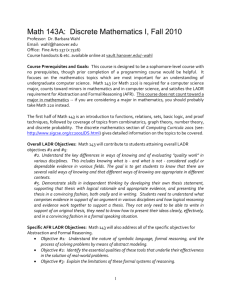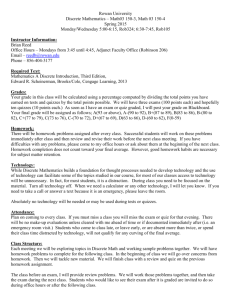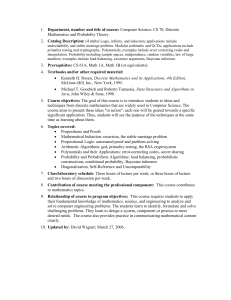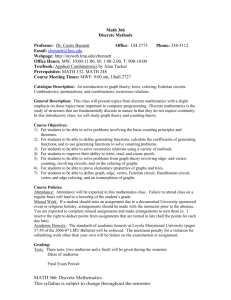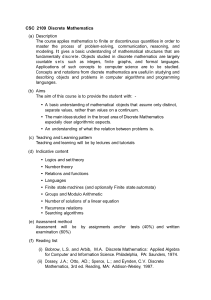Syllabus - Hanover College
advertisement
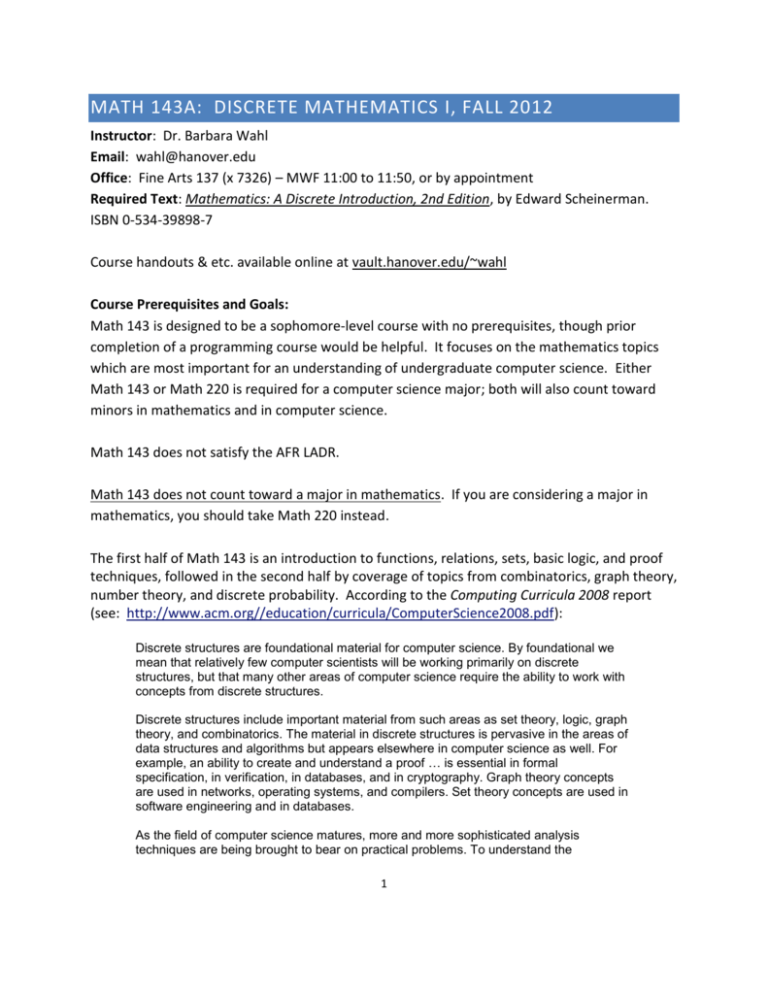
MATH 143A: DISCRETE MATHEMATICS I, FALL 2012 Instructor: Dr. Barbara Wahl Email: wahl@hanover.edu Office: Fine Arts 137 (x 7326) – MWF 11:00 to 11:50, or by appointment Required Text: Mathematics: A Discrete Introduction, 2nd Edition, by Edward Scheinerman. ISBN 0-534-39898-7 Course handouts & etc. available online at vault.hanover.edu/~wahl Course Prerequisites and Goals: Math 143 is designed to be a sophomore-level course with no prerequisites, though prior completion of a programming course would be helpful. It focuses on the mathematics topics which are most important for an understanding of undergraduate computer science. Either Math 143 or Math 220 is required for a computer science major; both will also count toward minors in mathematics and in computer science. Math 143 does not satisfy the AFR LADR. Math 143 does not count toward a major in mathematics. If you are considering a major in mathematics, you should take Math 220 instead. The first half of Math 143 is an introduction to functions, relations, sets, basic logic, and proof techniques, followed in the second half by coverage of topics from combinatorics, graph theory, number theory, and discrete probability. According to the Computing Curricula 2008 report (see: http://www.acm.org//education/curricula/ComputerScience2008.pdf): Discrete structures are foundational material for computer science. By foundational we mean that relatively few computer scientists will be working primarily on discrete structures, but that many other areas of computer science require the ability to work with concepts from discrete structures. Discrete structures include important material from such areas as set theory, logic, graph theory, and combinatorics. The material in discrete structures is pervasive in the areas of data structures and algorithms but appears elsewhere in computer science as well. For example, an ability to create and understand a proof … is essential in formal specification, in verification, in databases, and in cryptography. Graph theory concepts are used in networks, operating systems, and compilers. Set theory concepts are used in software engineering and in databases. As the field of computer science matures, more and more sophisticated analysis techniques are being brought to bear on practical problems. To understand the 1 computational techniques of the future, today’s students will need a strong background in discrete structures. OBJECTIVES Computer Science Major Objectives: Math 143 provides a foundation for the following computer science major objective, which is addressed more fully in CS 225. Algorithmically Savvy: Can evaluate many solutions and choose the best solution for each situation Can adapt existing algorithms to solve new problems Can create new algorithms to solve problems GRADING Attendance/participation: Each day you attend class and contribute to the day’s activities, you will earn an attendance score of 3. If you make an exceptional contribution to the day’s activities, you will earn a 4; typically, this involves presenting a problem solution at the board, or making an essential contribution to a class discussion. Occasional contributions may be so dazzling as to earn a 5. Excused absences count as 2 in your participation grade, and unexcused absences count as 0. Unexcused absences can easily put you in the ‘F’ range for participation, so please make it a habit to come to class each day! To request an “excused” absence, send me an email, as soon as possible, to explain the reason for your absence. Your daily attendance/participation scores will be averaged across the semester; an average of 3.0 is approximately equivalent to 85% (‘B’). Homework: The exercises at the end of each section are for you to work on outside of class. Please write clear and complete solutions to all of the assigned exercises. Assigned homework will be collected about once per week. I will spot-check your work for accuracy and also check for completeness. 2 Assignments are due at the beginning of class on the due date. Please have your papers organized, stapled, and ready to turn when class begins. Begin your work for each section on a new piece of paper, and staple your papers in the proper order. Late policy: Homework may be turned in up to 1 week late, for half credit. Exceptions may be made in case of illness or other excused absences, at my discretion. Plagiarism: Submission of someone else's work as your own is plagiarism. It is unacceptable behavior in all situations. Please consult your Hanover College Student Handbook for the consequences of academic dishonesty. Avoiding Temptation: If you are having a lot of trouble with an assignment, please see me as soon as possible. You should also feel free to discuss problem-solving approaches with your peers. But never copy someone else’s solution, and never let a classmate copy your solution. Sharing your work can be punished the same as copying. We can all be tempted to act badly when we are in dire straights. The best way to avoid any temptation to plagiarize (in this or in any class) is to start all your assignments as soon as possible, and to ask your instructor for help when needed, the sooner the better. I enjoy working one-on-one with my students; don’t hesitate to make an appointment to meet with me outside of class. Check with me before or after class, or drop me an email any time. Final Course Grade: Your overall course grade will be based on your class participation grade (10%), homework average (15%), and four exams (75%). The minimum score required for each overall letter grade is summarized in the following table. Class Participation Homework Exams Total 10% 15% 75% 100% A AB+ B BC+ 93 90 87 83 80 77 C CD+ D DF 73 70 67 63 60 0 3 Math 143 – Fall 2012 -- Tentative Schedule. We will use the following tentative schedule as a guide throughout the term, with adjustments made as necessary. Before coming to class, please read the material in the assigned section, record any questions you have, and try to solve some of the exercises. Week Date M W R F 1 3-Sep 1, 2 3 4 4, 5 2 10-Sep 6 7 8 9 3 17-Sep 10 11 review exam 1 4 24-Sep 11 13 14 15 5 1-Oct 16 18 18,19 19 6 8-Oct 19 20 20 21 7 15-Oct break 21 review exam 2 8 22-Oct 46 46 47 48 9 29-Oct 49 23 23 24 10 5-Nov 25 28 29 30 11 12-Nov 31 review exam 3 31 12 19-Nov 32 break break break 13 26-Nov 33 33 34 35 14 3-Dec 36 36 review review Section Topic Section Topic 1 Joy 21 Proof by Induction 2 Definitions 23 Functions 3 Theorems 24 Pigeonhole Principle 4 Proofs 26 Permutations 5 Counterexamples 28 Big-O and Other Notation 6 Boolean Algebra 29 Probability: Sample Space 7 Lists 30 Probability: Events 8 Factorial Notation 31 Conditional Probability and Independence 9 Sets, Part 1 32 Random Variables 10 Quantifiers 33 Expectation 11 Sets, Part 2 34 Div and Mod 13 35 Greatest Common Divisor 14 Relations Equivalence Relations 36 Modular Arithmetic 15 Partitions 46 Fundamentals of Graph Theory 16 Binomial Coefficients 47 Subgraphs 18 Inclusion - Exclusion 48 Connection 19 Proof by Contraposition and Contradiction 49 Trees 20 Smallest Counterexample 4 5
